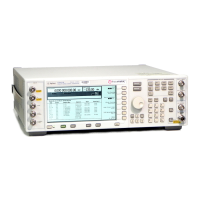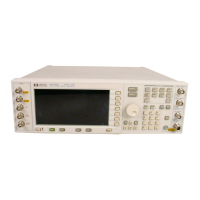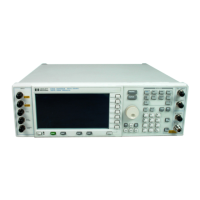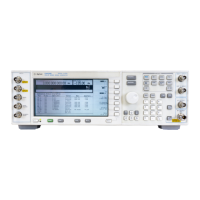31
www.agilent.com/find/esg
Advanced settings
Additional ESG parameters can be accessed by selecting the advanced button in Figure 35.
Typically, these parameters should not be modified unless there is a specific reason to do
so. A brief description is provided below and additional information on these parameters
can be found in the E4438C ESG Vector Signal Generator User’s Guide.
Figure 35. E4438C Advanced Settings menu.
Sampling rate
This parameter is automatically set when the oversampling ratio is defined in the Signal
Generation Setup menu. It is the rate at which the waveform I/Q samples are read from
the baseband generator memory during playback.
Baseband filter
The ESG provides three baseband filters [2.1 MHz, 40 MHz, and 50 MHz (through)].
The bandwidth of the baseband signal (1/2 the RF bandwidth) dictates the minimum
reconstruction filter bandwidth to be used. Depending on the oversampling ratio and where
the image frequencies appear, a wider bandwidth reconstruction filter may be selected.
Waveform scaling
The waveform scaling parameter is used to reduce the overshoot associated with the
DAC interpolation filter. At 100 percent, some overshoot may occur; therefore the default
setting is 95 percent. Further scaling may help to decrease DAC over-range occurrences.
Modulator attenuation
The modulator attenuation parameter is used to reduce the signal level driving the I/Q
modulation block. Adjusting the attenuation may reduce signal distortion and improve
the overall dynamic range.
RF blanking
When enabled, RF blanking improves the signal quality by increasing the on/off ratio
of the RF bursts. The ESG event 2 marker is internally routed to provide the RF blanking
signal. When RF blanking is active, the ALC is enabled only for the RF burst duration
and disabled otherwise.
Note: Marker 2 is set up as a gate signal on the Signal Studio-Bluetooth main menu. The gate is placed over
the payload portion of the packet. If RF Blanking is selected, then only the payload portion of the packet will be
transmitted, and the othr parts of the packet will be RF Blanked. For details on how to set markers, refer to the
E4438C ESG Vector Signal Generator User’s Guide.
ALC active
When enabled, the automatic level control (ALC) constantly monitors and controls the RF
output power of the ESG. There are some modulation conditions which the ALC circuit
cannot handle properly. For example, when RF blanking is disabled, DH3 and DH5 packets
experience slight amplitude variation during the packet transmission. This is due to the
ALC trying to correct for the bursted transmission. In these conditions, turning the ALC
off and using the ESG power search feature can achieve better power level accuracy.
Creating Signals

